Your Fave?
Thanks to all who commented on the Allen’s Hummingbird images. I am still excited about those. All are invited to leave a comment letting us know which of today’s three pelican images is their favorite, and why they made their choice.
What’s Up?
Carolyn Johnson, a shipmate on a Southern Ocean voyage about ten years ago, called me about two months ago wanting to sign up for the first San Diego IPT. I asked her about her gear — she was using Nikon at the time. We talked for a bit and I shared my experiences with Sony, especially with the a1 and the 200-600 G lens. I thought that that combo would be perfect for her. Wanting very much to improve her photography, she followed my advice and purchased both items from Bedfords (thank her very much). When we met early on Sunday morning, she had never used the camera. Now the word on the street is that the a1 is a difficult camera to use with a menu that is nearly impossible to understand. That may very well be true if you do not know how set up the camera. We had loaded my CAMSETA2.DAT onto Carolyn’s camera body. I sat with her for ten minutes demonstrating how to set the right exposure using (properly set-up) Zebras, and how to use the AF system. She was astonished as she watched the back of my camera as it tracked the eye seamlessly in with both Tracking: Spot S and Tracking: Zone. And when she tried it herself she was even more astonished.
She worked off the tripod for a bit, but when the light levels increased, she began hand holding her rig and did so with ease. Carolyn is on the petite side and is 78 years young. Not to mention that she learned to use her new camera in ten minutes flat.
She sent me a text that afternoon, and I quote:
Artie, I am sitting here in tears as the photos are so good. Thank you, thank you, thank you.
The fact is that set up correctly, the a1 is super-easy to learn to use. You can begin making excellent photographs in short order.
Today is Monday 17 January. The forecast for this morning is for mostly to mostly cloudy skies with a gentle breeze from the southeast. Carolyn’s daughter Marni was delayed a day and will be joining us early today. Wherever you are, and whatever you are doing, I hope that you too have a great day. This blog post took more than two hours to prepare and makes 67 consecutive days with a new one.
Please remember that you can find some great photo accessories (and necessities, like surf booties!) on Amazon by clicking on the Stuff tab on the orange/yellow menu bar above. On a related note, it would be extremely helpful if blog-folks who, like me, spend too much money on Amazon, would get in the habit of clicking on the Amazon logo link on the right side of each blog post when they shop online. As you might expect, doing so will not cost you a single penny, but would be appreciated tremendously by yours truly. And doing so works seamlessly with your Amazon Prime account.
Please remember that if an item — a Delkin flash card, or a tripod head — for example, that is available from B&H and/or Bedfords, is also available in the BAA Online Store, it would be great, and greatly appreciated, if you would opt to purchase from us. We will match any price. Please remember also to use my B&H affiliate links or to save 3% at Bedfords by using the BIRDSASART discount code at checkout for your major gear purchases. Doing either often earns you free guides and/or discounts. And always earns my great appreciation.
|
|
|
This image was created on 15 January 2022, my first morning in La Jolla. Standing at full height on the sidewalk, I used the no-longer-available Induro GIT 304L/Levered-Clamp FlexShooter Pro-mounted Sony FE 600mm f/4 GM OSS lens and The One, the Sony Alpha 1 Mirrorless Digital Camera). IS 640. The exposure was determined via Zebras with ISO on the rear wheel: 1/320 sec. at f/4 (wide open) in Manual mode. AWB at 8:44:26am on a mostly sunny morning. Tracking: Spot S AF-C performed very well. Be sure to click on the image to enjoy a higher-res version. Image #1: Brown Pelican on curved branch perch |
The Discovery
I was working for two hours with the amazing Sony FE 70-200mm f/2.8 GM OSS II lens when I saw this bird on the crazy-beautiful perch. There was a small opening through the bushes and it looked as if I could get a long lens on the bird. So I headed back to the car and grabbed the 600 and the tripod. I was thrilled when I returned and found the bird still sitting on the same perch. Image #1 is a straight-forward horizontal portrait of the whole bird. I found the distant cliff-wall background to be quite lovely.
I almost forgot to mention that at times on Sunday morning it was drizzling pretty good.
|
|
|
This image was created on 15 January 2022, my first morning in La Jolla. Standing at full height on the sidewalk, I used the no-longer-available Induro GIT 304L/Levered-Clamp FlexShooter Pro-mounted Sony FE 600mm f/4 GM OSS lens and The One, the Sony Alpha 1 Mirrorless Digital Camera). IS 640. The exposure was determined via Zebras with ISO on the rear wheel: 1/320 sec. at f/4 (wide open) in Manual mode. AWB at 8:45:17am on a mostly sunny morning. Tracking: Spot S AF-C performed very well. Be sure to click on the image to enjoy a higher-res version. Image #2: Brown Pelican shaking off rain |
Missing the Head Throw!
Working horizontally, when the bird did a perfect head throw I was dead in the water; I did not even press the shutter button. So I switched to vertical, but alas, that was the last head throw. The bird did, however, raise its head while shaking off the rain. Score one for vertical. Would you have replaced the eye in this frame? Why or why not?
|
|
|
This image was created on 15 January 2022, my first morning in La Jolla. Standing at full height on the sidewalk, I used the no-longer-available Induro GIT 304L/Levered-Clamp FlexShooter Pro-mounted Sony FE 600mm f/4 GM OSS lens and The One, the Sony Alpha 1 Mirrorless Digital Camera). IS 1000. The exposure was determined via Zebras with ISO on the rear wheel: 1/500 sec. at f/4 (wide open) in Manual mode. AWB at 8:44:26am on a mostly sunny morning. Tracking: Spot S AF-C performed very well. Be sure to click on the image to enjoy a higher-res version. Image #3: Brown Pelican stretching |
Score Two for Vertical
When the bird leaned forward to stretch its right wing, it fit perfectly into the still vertical frame. This image was cropped a bit on all sides but the bottom.
|
|
|
San Diego offers a wealth of very attractive natural history subjects, including and especially the Pacific race of California Brown Pelican. With annual visits spanning more than four decades, I have lots of photographic experience there … Click on the composite to enjoy a larger version. |
The 2022 San Diego Brown Pelicans (and more!) Mini IPT. Monday 24 January thru the morning session on Wednesday 26 January 2022. Three mornings and two afternoons: $1649.00. Deposit: $499.00. Limit: 6 photographers
Join me in San Diego to photograph the spectacular breeding plumage Brown Pelicans with their fire-engine red and olive green bill pouches; Brandt’s (nesting with eggs and possibly chicks) and Double-crested Cormorants; breeding plumage Wood and Ring-necked Duck; other duck species possible including Lesser Scaup, Redhead, Northern Shoveler and Surf Scoter; a variety of gulls including Western, California, and the gorgeous Heermann’s, all in full breeding plumage; shorebirds including Marbled Godwit, Willet, Sanderling and Black-bellied Plover; many others are possible including Least, Western, and Spotted Sandpiper, Whimbrel, Black and Ruddy Turnstone, Semipalmated Plover, and Surfbird; Harbor Seals (depending on the current regulations) and California Sea Lions. And as you can see by studying the IPT cards, there are some nice bird-scape and landscape opportunities as well. Not to mention a ton of excellent flight photography opportunities and instruction.
Please note: where permitted and on occasion, ducks and gulls may be attracted (or re-located) with offerings of grains or healthy bread.
Learning Exposure, Whether You Like It Or Not
Whether you like it or not, we will be beating the subject of exposure like a dead horse. In every new situation, you will hear my thoughts on the exposure situation along with my thoughts on both Nikon and Canon histograms and SONY Zebras. Whether you like it or not, you will learn to work in manual mode and to get the right exposure every time as long as a bird gives you ten seconds with the light constant. (Or two seconds with SONY zebras…) And you will learn what to do when the light is changing constantly. What you learn about exposure is one of the great takeaways on every IPT.
|
|
|
Though the pelicans will be the stars of the show on this IPT, there will be many other handsome and captivating subjects in wonderful settings. Click on the composite to enjoy a larger version. |
It Ain’t Just Pelicans
With gorgeous subjects just sitting there waiting to have their pictures taken, photographing the pelicans on the cliffs is about as easy as nature photography gets. With the winds from the east almost every morning there is usually some excellent flight photography as well, often with 70-200mm lenses! And the pelicans are almost always doing something interesting: preening, scratching, bill pouch cleaning, or squabbling. And then there are those crazy head throws that are thought to be a form of intra-flock communication. You will be guided as to how to make the best of all of those opportunities. And depending on the weather and local conditions and tides, there are a variety of other fabulous photo chances available in and around San Diego.
|
Did I mention that there are lots of great birds and natural history subjects in San Diego in winter? Click on the composite to enjoy a larger version. |
The San Diego Details
This IPT will include five three hour morning photo sessions, four one and one-half afternoon photo sessions, four working brunches that will include image review and Photoshop sessions. On rare cloudy day occasions, we may — at my discretion, stay out in the morning for a long session and skip that afternoon. To ensure early starts, breakfasts will be your responsibility. And so that we can get some sleep, dinners will be on your own as well. In the extremely unlikely event that Goldfish Point is closed due to local ordinance (or whimsy) — that has never happened in the past fifty years, I will of course do my very best to maximize our photographic opportunities.
A $499 deposit is required to hold your slot for this IPT. Best would be to call Jim or Jennifer at the office with a credit card at 863-692-0906. Your balance, payable only by check, is due immediately.
|
Variety is surely the spice of life in San Diego. Click on the composite to enjoy a larger version. |
Getting Up Early and Staying Out Late
On all BIRDS AS ART IPTS including and especially the San Diego IPT, we get into the field early to take advantage of unique and often spectacular lighting conditions and we stay out late to maximize the chances of killer light and glorious sunset silhouette situations. We often arrive at the cliffs a full hour before anyone else shows up to check out the landscape and seascape opportunities.
Typos
With all blog posts, feel free to e-mail or to leave a comment regarding any typos or errors.

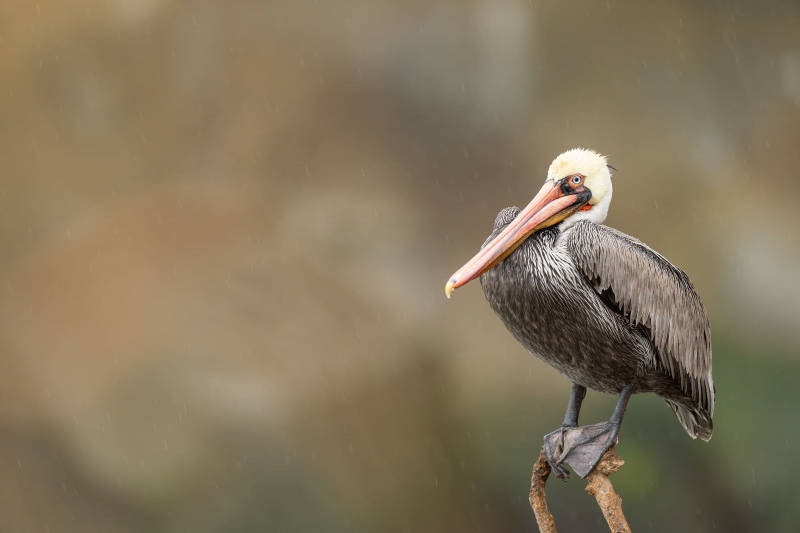
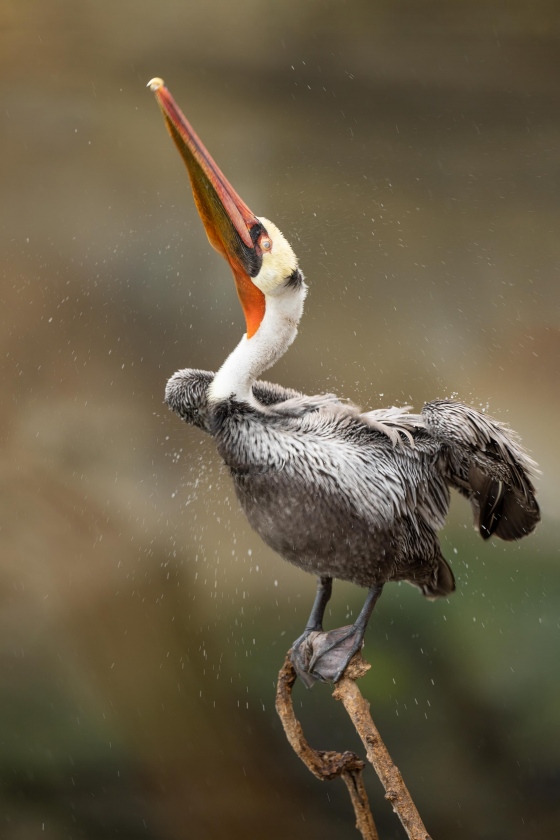
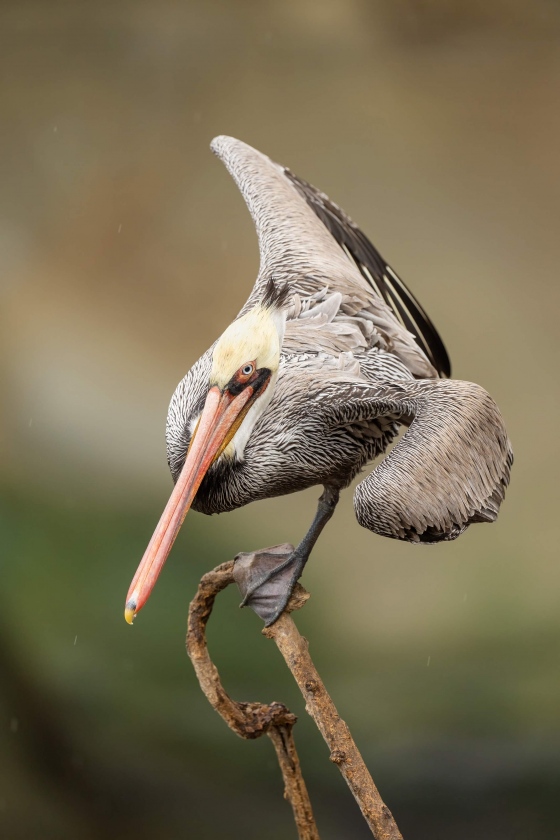
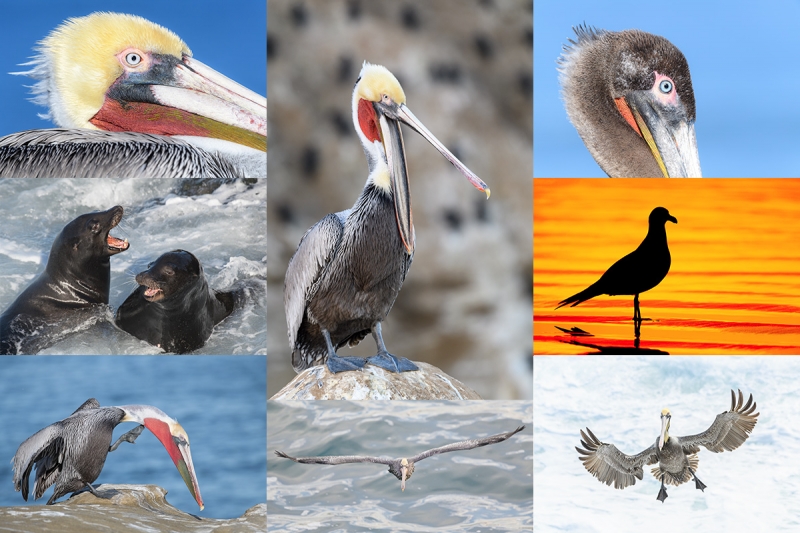
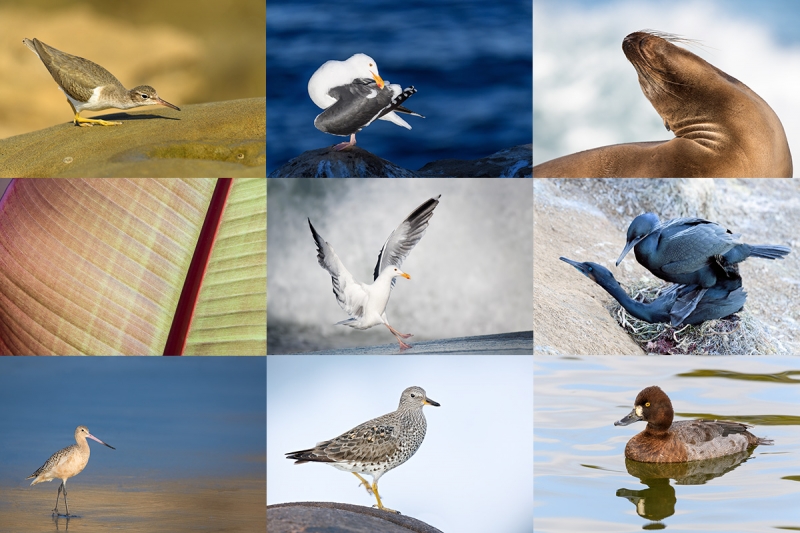















#2 would be my favorite if the eye were darker in the smaller size image. Can’t really tell what it is there. BUT in the larger of #2 the eye shows up fine. I like the action with all the water drops and the beautiful background.
Best to evaluate the images by viewing the high res versions; that’s why I make them 🙂
with love, artie
Number 3 is excellent, it has a unique pose; balancing on one leg and holding on the perch.
Many thanks, Ramu.
with love, artie
Image #1 is my favourite. I like the beautiful colours of the bird, the relaxed pose of the pelican, and the lovely muted colours of the background.
Thanks, Ted. The colors were beautifully muted by the rain earlier in the day.
with love, artie
I have never seen a pelican perched like that. Great set of images and no I would not replace the eye. Thanks for sharing.
Hey Artie, crazy wonderful pelican images. I have never seen or imagined that a pelican would use a perch like that. Thank you for sharing.
Joe and James, I posted one on the blog last year on a similar perch in the same area. That perch is gone, but this one is way better. We had a bird on it again today. There is room only for two photographers at a time.
with love, artie